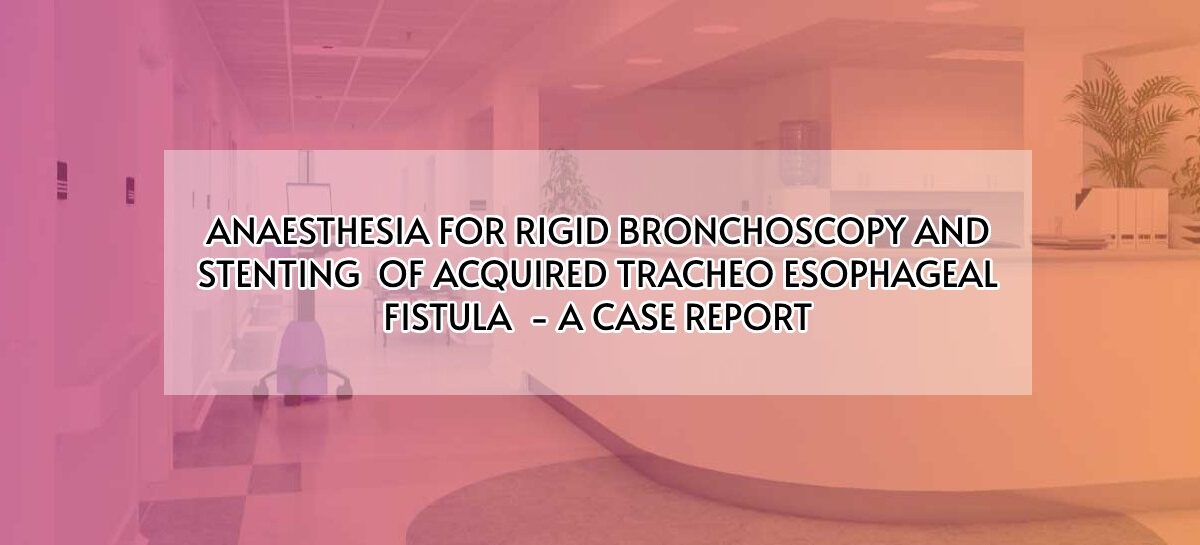61-year male known case of COPD, Diabetes mellitus, hypertension, Carcinoma oesophagus which was diagnosed in 2023 for which he received chemotherapy and radiotherapy. OGD (2024) showed oesophageal stricture and dilatation was done. PET CT (2024) revealed residual disease, was started on chemotherapy. Feeding jejunostomy was done. Bronchoscopy revealed left vocal cord palsy.
Patient presented to ER with compliant of breathlessness and desaturation and diagnosed as aspiration pneumonia.
Patient received in ICU in view of desaturation and connected on NIV support.
CECT chest revealed trachea oesophageal fistula and bilateral diffuse consolidation.
Check bronchoscopy was done which showed TRACHEO ESOPHAGEAL FISTULA 1*2 CM IN POSTEROLATERAL WALL OF TRACHEA 5 CM FROM CARINA.
Hence planned for rigid bronchoscopy and self expanding metallic stent placement.
PRE-OPERATIVE PLANNING:
- Routine investigations were done, and blood investigations found to be within normal limits except for increased total WBC count. sputum c/s revealed pseudomonas growth and started on appropriate antibiotics .
- ECG showed sinus tachycardia.
- ECHO revealed LVEF -30% RWMA + ANTERIOR AND ANTEROLATERAL WALL LV APEX HYPOKINETIC.
- Cardiologist opinion was obtained, high risk was given for procedure, and advised T. Ivabid 5 mg and statins.
- Patient was on LMWH, advised to stop 12 hrs before surgery.
- NIV support was tapered to nasal prongs, he was maintained SPO2 -92% with 2 litres of oxygen. HR-120/MIN RR- 20/MIN.
- ABG was taken on the day of surgery found to have mild respiratory alkalosis.
- Advised to continue nebulization and routine medications.
- Plan of anaesthesia and high risk associated with anaesthesia and surgery, need for post operative elective ventilation were clearly explained to patient and attender with written consent.
- NPO guidelines were followed.
- Premedication’s – Inj Pantoprazole 40 mg iv, Inj palanosetron 0.075 mg were given.
INTRAOPERATIVE MANAGEMENT:
- Patient was positioned supine, and all monitors were attached – pulse oximetry, NIBP and ECG.
- Arterial line was placed in left radial artery for continuous blood pressure monitoring.
- PICC line was already placed in ICU.
- Pre induction vitals – HR-130/min; sp02- 92 with 2 litres oxygen; Bp- 180/90mmhg.
- Preoxygenated with 100% oxygen via facemask for 3 mins.
- Induction done with Inj fentanyl 100 mcg, Inj morphine 10 mg given in titrated dose.
- After establishing successful bag and mask ventilation, inj Cisatracurium 10mg iv given.
- Usually, placement of metallic stenting requires rigid bronchoscopy.
- Hence after adequate preoxygenation rigid bronchoscopy done, circuit was connected through the side arm of a ventilating bronchoscope and manual ventilation was done with high flow and high FIO2 (100% O2) with intermediate oxygen flush to overcome the leak.
- Once after bronchial toileting was done, ventilation was improved.
- Initial attempt of stent deployment was failed and bag and mask ventilation were done intermittently.
- After adequate ventilation, again rigid bronchoscopy was done TEF noted, self-expanding metallic stent deployment done in trachea and position was confirmed .
- Airway was secured with 7 mm size endotracheal tube placed @ 18 cms at lips so that it won’t disturb the stent.
- Patient was connected to ventilator under volume control mode, adequate tidal volume was achieved, and airway pressure was maintained.
- Patient had hypotension towards the end of the procedure and started on minimal nor adrenaline support.
POST OPERATIVE MONITORING:
- Post op ABG shows minimal hypercarbia PCO2- 54
- Patient was shifted to ICU for elective postoperative ventilation.
- Mechanical ventilation was performed by pressure control mode with fio2 – 40% RR – 18/min
- Post operative ECG and cardio review was adviced .
- He was weaned from ventilatory support on pod-2 to HFNC and off vasopressors and shifted to ward on pod-5.
CASE DISCUSSION:
Tracheo oesophageal fistula is rarely seen in adults but has a very high mortality rate due to aspiration of GI contents , pulmonary complications and sepsis. Malignancy is the common cause for acquired TEF.
In this case Carcinoma oesophagus is the cause for TEF. Other cause includes iatrogenic and traumatic causes. Open repair or airway stents can be used for TEF. Airway stents are used in the management of central airway obstruction.
Anaesthetic management during TEF stenting includes challenges of
- Possible difficult intubation
- Sharing the common airway with the pulmonologist/ surgeon.
- Troubles during apnoea period
- Leakage during ventilation
- Require Deep plane of anesthesia.
Here intermittent apnoeic periods were managed with high flow high fio2 insufflation whenever required. As it involves a shared airway, clear and effective communication between the anaesthetist and pulmonologist / surgeon is required.
- Flexible bronchoscopy can be undertaken with adequate local anaesthetic topicalization of the airway. But Rigid bronchoscopy requires general anaesthesia and deep plane of anaesthesia, hence controlled ventilation is required.
- Anaesthesia may be induced using either an inhalational or intravenous technique.
- Irrespective of the airway used, anaesthesia may be maintained with either a volatile anaesthetic agent or TIVA.
- For procedures performed using a rigid bronchoscope, TIVA offers several advantages. To facilitate inhalation anaesthesia, circuit should be connected to a side port via a swivel connector. However, this approach require intermittent occlusion of working port of bronchoscope and leakage of volatile anaesthetic agents from the airway result in operating room pollution.
- Hence TIVA in combination with JET VENTILATION is typically preferred in rigid bronchoscopy.
- Jet ventilation involves delivery of high flow, compressed gas at high pressure (0-3 bars).
- Adequate depth of anaesthesia should be maintained.
- Long acting opioids are best avoided or given at low doses as they cause postoperative respiratory depression and reduce patient ability to clear secretions.
COMPLICATIONS:
Early – hypercarbia, respiratory acidosis, hypoxemia, Acute airway obstruction, airway injury, Tension pneumothorax.
Late – stent migration, stenosis, bacterial colonisation, granuloma.
CONCLUSION
Anaesthesia for procedures involving the central airway is challenging. Challenges for the anaesthetist include safely inducing and maintaining anaesthesia, ensuring adequate gas exchange and managing immediate life-threatening postoperative complications. Effective ventilation strategies, effective FOB usage, sufficient depth of anaesthesia provide better oxygen saturation, hypercarbia elimination and hemodynamic stability.
REFERENCE:
- Anaesthesia for airway stenting – BJA N.Barnwell M.Lenihan
- Yazıcıoğlu H, Özler B, Tezcan B, Subaşı M, Yekeler E. A challenging anaesthetic management of acquired tracheo-Esophageal fistula operation. Int J Case Rep Images 2018;9:100932Z01HY2018.
- Inada T, Umemoto M, Ohshima T, Sawada O, Nakamura Y. Anaesthesia for insertion of a Dumon stent in a patient with a large tracheo-esophageal fistula. Can J Anaesth. 1999 Apr;46(4):372-5. doi: 10.1007/BF03013231. PMID: 10232723.



 Dr. Velmurugan Desingh,
Dr. Velmurugan Desingh, Dr. S. Dhiveya
Dr. S. Dhiveya